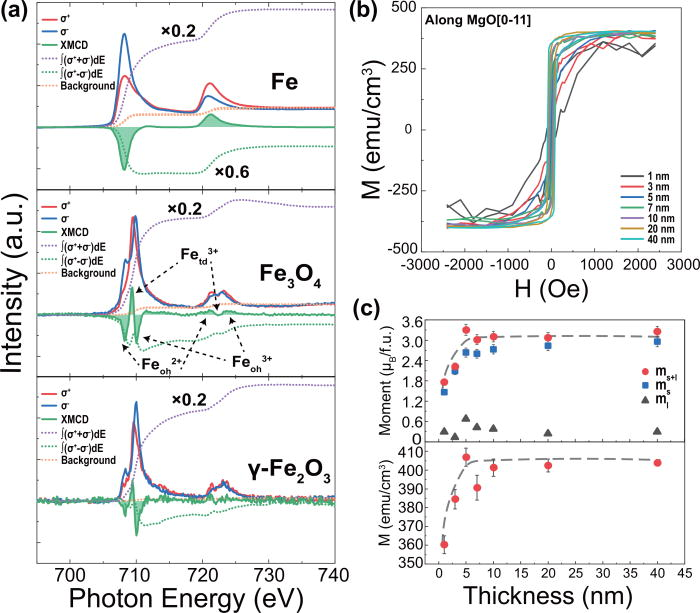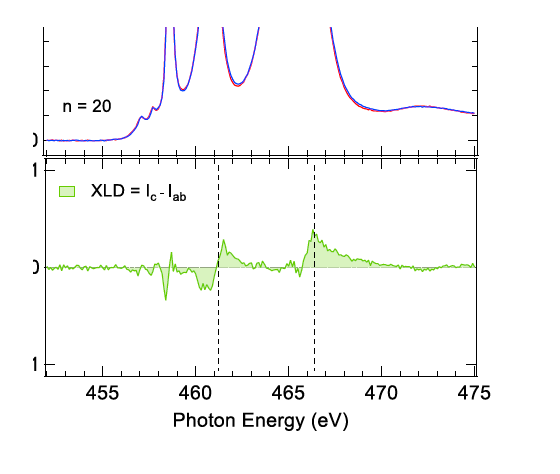1. Direct observation of spin polarization in epitaxial Fe3O4(001)/MgO thin films grown by magnetron sputtering
南京大学 徐永兵 陆显扬
Appl. Phys. Lett. 120, 182403 (2022) doi.org/10.1063/5.0091241
Single-crystal Fe3O4(001)/MgO(001) films of different thicknesses have been studied by the XMCD method, and it is found that spin-polarization values close to the theoretical results are found in Fe3O4 films 20 nm thick, while the spin-polarization is maximal at film thicknesses of 40 nm. A series of results suggests that it is not lattice mismatch, but rather the opposite phase domain boundaries that reduce the spin polarization.

Fig.1 (a) Fe L2,3-edge XAS and XMCD spectra of 20 nm Fe (0 sccm O2), 5 nm Fe3O4 (1.5 sccm O2), and 20 nm γ-Fe2O3 (2 sccm O2). (b) VSM magnetization curves of Fe3O4 films with different thicknesses. (c) MS and moment of Fe3O4 films with different thicknesses. The dashed lines are guidelines for the eye.
2. Engineered Kondo screening and nonzero Berry phase in SrTiO3/LaTiO3/SrTiO3 heterostructures.
中科院物理所 刘笑然
Phys. Rev. B. 106 165421 (2022) DOI: 10.1103/PhysRevB.106.165421
Controlling the interplay between localized spins and itinerant electrons at the oxide interfaces can lead to exotic magnetic states. Here we devise SrTiO3/LaTiO3/SrTiO3 heterostructures with varied thickness of the LaTiO3 layer (𝑛 monolayers) to investigate the magnetic interactions in the two-dimensional electron gas system. The heterostructures exhibit significant Kondo effect when the LaTiO3 layer is rather thin (𝑛 =2,10), manifesting the strong interaction between the itinerant electrons and the localized magnetic moments at the interfaces, while the Kondo effect is greatly inhibited when 𝑛 =20. Notably, distinct Shubnikov–de Haas oscillations are observed and a nonzero Berry phase of π is extracted when the LaTiO3 layer is rather thin (𝑛 =2,10), which is absent in the heterostructure with thicker LaTiO3 layer (𝑛 =20). The observed phenomena are consistently interpreted as a result of subband splitting and symmetry breaking due to the interplay between the interfacial Rashba spin-orbit coupling and the magnetic orderings in the heterostructures. Our findings provide a route for exploring and manipulating nontrivial electronic band structures at complex oxide interfaces.

Fig.1 X-ray absorption spectra (XAS) and X-ray linear dichroism (XLD) spectra of n = 20 sample. The photon energy was tuned to the Ti L2,3 absorption edges, and out-of-plane (E//c) and in-plane (E//ab) linearly polarized x-rays were applied to measure the absorption spectra using the total electron yield (TEY) detection mode at 80 K. The XLD spectra is defined as Ic Iab. Since the probing depth of TEY is only about 1-2 nm from surface into the sample, the observed results reflect mainly the topmost interface between SrTiO3 and LaTiO3 layers. The observed XLD signal in our sample indicate a splitting of the dxy and dxz/yz orbitals at the interface with energy Edxy < Edxz/yz. Such a splitting configuration is consistent with published data in LaTiO3/SrTiO3 and LaAlO3/SrTiO3 systems [2, 3]. Nevertheless, considering the fact that the observed XLD signal is rather small (less than 5%), the splitting does not render a complete orbital polarization. As a result, although the carriers would have a tendency to occupy the dxy orbital, both the dxy and dxz/yz bands are located at the Fermi level occupied by carriers, and contribute to the electrical transport. References [1] A. Ohtomo, D. A. Muller, J. L. Grazul, and H. Y. Hwang, Nature 419, 378 (2002). [2] Y. Cao, X. Liu, P. Shafer, S. Middey, D. Meyers, M. Kareev, Z. Zhong, J.-W. Kim, P. J. Ryan, E. Arenholz, and J. Chakhalian, npj Quant. Mater. 1, 16009 (2016)
3. Intrinsically elastic polymer ferroelectric by slight crosslinking
中国科学院宁波材料所 胡本林教授
Science (2023) DOI: 10.1126/science.adh25
Ferroelectrics are an integral component of the modern world and are of importance in electrics, electronics, and biomedicine. However, their usage in emerging wearable electronics is limited by inelastic deformation. We developed intrinsically elastic ferroelectrics by combining ferroelectric response and elastic resilience into one material by slight cross-linking of plastic ferroelectric polymers. The precise slight cross-linking can realize the complex balance between crystallinity and resilience. Thus, we obtained an elastic ferroelectric with a stable ferroelectric response under mechanical deformation up to 70% strain. This elastic ferroelectric exerts potentials in applications related to wearable electronics, such as elastic ferroelectric sensors, information storage, and energy transduction.
附件下载:
